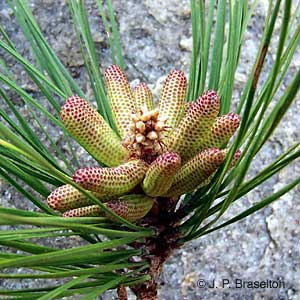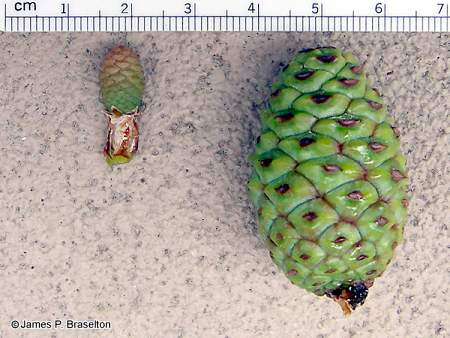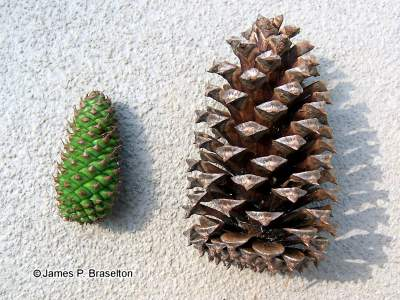
Gymnosperms are one of the two groups of seed plants. The flowering plants (angiosperms), are the other. In going from mosses and ferns to the seed plants, we see a very significant difference in plant life cycles. In mosses and ferns the propagating units for new individuals are spores. In the seed plants, gymnosperms and angiosperms, the propagating units for new individuals are seeds. Spores are single, haploid cells, and develop into gametophytes. Seeds, in contrast, are complex structures that contain an immature sporophyte, the embryo.
The remainder of this reading is concerned with how a seed is formed. Although seeds of gymnosperms and angiosperms have similarities, this and the reading for angiosperms make several important distinctions between seeds of gymnosperms and angiosperms. A major difference between gymnosperms and angiosperms is how the seeds are attached to the plant. Seeds of gymnosperms are not enclosed; instead, they are open to the surrounding environment. This type of unprotected seed is a naked seed. The name gymnosperm means "naked seed." In contrast, seeds of angiosperms are enclosed in a special structure that at maturity is called the fruit.
There are going to be more new terms for you to learn as development of seeds of gymnosperms and angiosperms is considered. Be patient and try not to get bogged down with the new terminology. An important point to keep in mind is that you already know the basic stages in the life cycles of gymnosperms and angiosperms. Look back at readings for bryophytes and ferns, draw a circle, and fill in the words gametes, sperm, egg, fertilization, zygote, sporophyte, sporangium, meiosis, spores, gametophyte, antheridium and archegonium.
Gymnosperms are a diverse group of plants, one group of which has cones involved in reproduction. The cone-producers, botanically called conifers, are the gymnosperms most commonly seen. Pines, spruces, and firs are conifers. Since you probably are most familiar with pines, we use them for our example of a gymnosperm life cycle.
The pine tree that you and I recognize as a pine tree is the sporophyte. The sporangia of conifers are contained in special structures, the strobili (cones). Upon close examination of a pine tree, we see that there are two types of strobili: 1) the large woody strobilus that most people call a "pine cone"; and 2) a much smaller, delicate, yellow strobilus. Each type of strobilus produces its own type of spore; there are two types of spores produced by conifers.
This condition where two types of spores are produced is referred to as heterospory as opposed to homospory as occurs in mosses and ferns. Gymnosperms, therefore, as exemplified by pine trees, are heterosporous. A major distinction we can make between seed plants (gymnosperms and angiosperms) and the non-seed plants (mosses and ferns) is that seed plants are heterosporous and non-seed plants are homosporous. Back to the example of a gymnosperm, the pine tree.
The smaller strobili of a pine tree occur in clusters at the tips of branches. The smaller strobili properly are called staminate strobili, but many people, including botanists, often refer to them as "male cones" or "male strobili." Think of each male strobilus as a very shortened branch, and each scale-like leaf with two sacs attached to the underside. The sacs are the sporangia. Within each sporangium meiosis occurs in many cells; many haploid spores are produced.

A cluster of male strobili (cones) of pine at the tip of a branch in early spring prior to the release of pollen.
The spores produced in the sporangia of the male strobili are smaller than the spores produced in the larger strobili. The smaller spores are called microspores. Each microspore develops into a gametophyte that itself is very small. The small gametophyte is called the microgametophyte. Microgametophytes also are called pollen. Each pollen at maturity consists of only a few cells. Two cells are the sperm. Note that each cell of the microgametophyte, including the two sperm, is haploid. Also, there is no antheridium in which the sperm are produced.
In the spring, pine trees produce millions of pollen grains. If you are one of those unfortunate individuals who is allergic to pine pollen, you will sneeze a lot when pollen is being released from sporangia in male cones. If you have a pine tree near your house, you will dust up a lot of yellow dust, the pine pollen, from your furniture.
The larger strobilus of the pine tree is what most people think of as a pine cone, sometimes referring to it as the "female cone" or "female strobilus." In the female cone is a structure, the ovule, that contains the megasporangium. If you think of a pine cone as a shortened branch, each scale-like leaf contains two ovules on the topside of the leaf. The integument of the ovule protects the megasporangium. An opening in the integument, the micropyle. A space between the micropyle and the megasporangium is called the pollen chamber. Both micropyle and pollen chamber have important roles in the pine life cycle.
Only one cell in each megasporangium goes through meiosis. In addition, only one haploid megaspore is produced by meiosis in each megasporangium. The single megaspore develops into a multicellular megagametophyte. Within the megagametophyte are several archegonia, each with an egg. Note that all of this development has occurred within the ovule sitting on the leaf-like scale in a pine cone.
To complete the life cycle, a sperm will fuse with an egg to form a zygote, the first cell in the diploid, sporophytic generation. For this to eventually happen, the first step is for the pollen to float through the air and land on top of a scale in the female cone. The transfer of pollen from the male cone to the female cone is pollination. When an ovule is receptive, a drop of sticky fluid is produced and fills the pollen chamber; some fluid exudes through the micropyle. Pollen sticks in the fluid exuding from the micropyle. As the fluid dries, it and the stuck pollen are drawn in through the micropyle. The micropyle grows shut, entrapping pollen in the pollen chamber.
The pollen germinates and a tube digests through the megasporangium and into the megagametophyte. Eventually the pollen tube grows close to an archegonium and ruptures, releasing a sperm into the egg. The fused sperm and egg is the diploid zygote, the first cell in the sporophytic phase of the life cycle.
Remember that all of this has been happening inside the ovule! The zygote goes through cellular division, and after many divisions an immature sporophyte is developed within the ovule and is surrounded by the megagametophyte. The immature sporophyte is an embryo. While this is happening the outermost layer of the ovule, the integument, develops into the seed coat. We now have a mature pine seed.
A seed is a matured ovule. In this example of a gymnosperm, the pine, the matured ovule consists of a seed coat, megagametophyte, and embryo. This is a very complex structure if you pause to think about it. The seed coat is diploid tissue from the original parent sporophyte. The megagametophyte is a haploid plant that developed from a megaspore produced by the original sporophyte. The embryo is a new diploid sporophyte. Looking at it another way, a pine seed really is a combination of three different plants.

Female strobili (cones) of pine: the one on the left a young cone several weeks after pollination, the cone on the right a year after pollination.
A mature female pine cone is woody. The scales separate and the seeds drop off the scales. Most pine cones you pick up during a walk in the woods already have released their seeds. But if you look carefully at the topside of one of the scales you can see two oblong indentations where the ovules (seeds) were attached. To see younger stages of pine cones, look on the tree. Since it takes two years for a cone to develop to maturity, you often can find pine cones of different stages of development on the same tree. If you want to see what a pine seed looks like, or even taste one, go to a fine food store and buy a jar of "pine nuts" —they are pine seeds.

Female strobili (cones) of pine: the one on the left a young cone a year after pollination, the right a mature cone that has opened and released the seeds.
Upon germination of the seed, the young sporophyte begins to grow. It may take several to many years before the new sporophyte has matured enough to produce cones, thus completing the life cycle.
In summary of the gymnosperm life cycle as exemplified by pines, gymnosperms are heterosporous vascular plants with naked seeds. Microspores are produced by meiosis in male strobili and develop into pollen (microgametophytes). Megaspores are produced within ovules in female cones and develop into megagametophytes. The matured ovule (seed) consists of a seed coat, megagametophyte, and embryo.